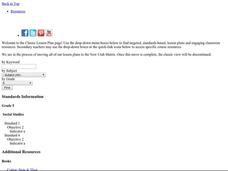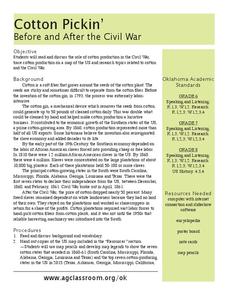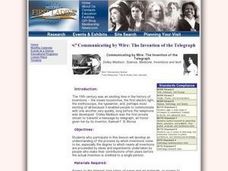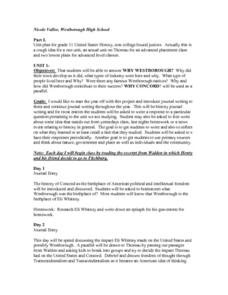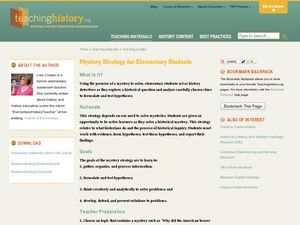Curated OER
The Cotton Gin
High schoolers are introduced to an early American inventor, Eli Whitney, and his experiences with the Patent Office. The economic importance of the cotton gin and its impact on slavery are also addressed.
Curated OER
Eli Whitney's Patent for the Cotton Gin
Students review the U.S. patent laws by researching Eli Whitney's petition for a renewal on his cotton gin patent. They examine documents to assess the impact of the cotton gin, role-play the patent hearing and discuss the effects of...
Curated OER
The Impact of the Cotton Gin
Fourth graders study Eli Whitney and the cotton gin. In this lesson on the cotton gin, 4th graders use primary and secondary sources to gather information about Eli Whitney, the cotton gin that he invented and how it changed the south.
Curated OER
King Cotton
Fifth graders examine the manufacturing of cotton. In this cotton and slavery lesson, 5th graders review background information about cotton and slavery. Students examine a real cotton ball and discuss why it was painful to pick....
Curated OER
King Cotton
Sixth graders investigate the farming process for cotton and its impact on the United States history. In this cotton farming lesson, 6th graders read background information on the cotton farming process and discuss the role of slavery in...
Curated OER
Cotton Production and Milling
Students examine cotton production and milling. They compete in a hand-ginning contest to realize how difficult it was to separate the seeds from the fibers of cotton. They discuss why Eli Whitney's cotton gin was an important invention.
Curated OER
King Cotton
Fifth graders explore the cotton plant. For this cotton lesson, 5th graders research the process of growing cotton. Students explore the economic and cultural differences in the states that grew cotton for trade and industry.
Curated OER
Cotton Pickin' Before and After the Civil War
Students explore the impact of cotton. In this economics lesson, students listen to a lecture presented by their instructor on the Southern crop of cotton and its impact on the South prior to and following the Civil War. Students...
Curated OER
Clothesline Sleuth
Sixth graders investigate the origins of clothing production. In this Social Studies lesson, 6th graders examine the components of agriculture involved in making clothes. Students research cotton.
Curated OER
Jane's Dress Worksheet Series
Students read a story from MotherGooseCaboose.com prior to answering a series of questions about it. After examining the story for patterns, they compose their own tale including a title and details.
Curated OER
Images of Slavery
Middle schoolers analyze the ways slavery shaped social and economic life in the South after 1800, methods of passive and active resistance to slavery; escaped slaves and the Underground Railroad, and the ending of the Atlantic slave trade.
Curated OER
COTTON AND SLAVERY IN ARKANSAS
Fifth graders read about the cotton industry in America and demonstrate the roll of slaves picking and removing seeds from a boll of cotton. The relationship between slaves and cotton production is established.
National First Ladies' Library
Eli Whitney: A Top Ten Inventor?
Middle schoolers conduct research and present their findings in a persuasive manner. Then they work in groups to enhance the development of cooperative work skills. Students also present their findings through persuasive skills in...
Curated OER
Industrial Revolution
Students cite the importance of the steam engine, cotton gin and steel making process. They describe conditions in cities due to increased industrialization. They explain how the living and working conditions led to the development of...
Curated OER
JUST A MATTER OF TIME
Young scholars recognize the dynamic changes in themselves and in agriculture that have occurred through the years. They are shown pictures of a baby or students are asked to think of their little brothers or sisters or themselves in...
Curated OER
Changes in the New Nation
Students explore how technology has slowly changed the world, starting in the 18th Century. In this United States History lesson, students work in teams to complete numerous activities that compare and contrast life before and after...
Curated OER
From Bolls to Bolts
Fifth graders understand the importance of cotton in America. In this cotton instructional activity, 5th graders view a video on cotton from plant to market. Students examine cotton bolls and participate in other activities around the...
Curated OER
From Bolls To Bolts
Students investigate the concept of cotton manufacturing. The skills of setting statements in chronological order is developed. They are shown pictures of products and place them in order. The lesson plan includes background information...
Curated OER
Thoreau
Eleventh graders answer the question Why Westborough? Why did their town develop as it did, what types of industry were here and why. They are introduced to journal writing. Students free write about ideas that stand out from class. ...
National Endowment for the Humanities
People and Places in the North and South
North and South: two opposite directions and two opposite economic and social systems in time of the Civil War. Pupils peruse census websites and primary source photographs to understand what life was like for the everyday person before...
National Endowment for the Humanities
Factory vs. Plantation in the North and South
North is to factory as South is to plantation—the perfect analogy for the economy that set up the Civil War! The first lesson in a series of five helps teach beginners why the economy creates a driving force for conflict. Analysis of...
National Endowment for the Humanities
Life Before the Civil War
American life before the Civil War was very different from American life today. To show this difference in a full spectrum, learners compare two communities that illustrate the differences between Northern and Southern life. Throughout...
National Endowment for the Humanities
Women's Lives Before the Civil War
Women's lifestyles before the Civil War made a huge impact as a point of causation. Give middle schoolers the opportunity to view firsthand the lives of women before the Civil War. They analyze primary source documents, view photographs,...
Curated OER
Mystery Strategy for Elementary Students
Learners of all ages solve historical mysteries. Elementary learners research historical topics by organizing information presented by their instructor, formulating hypotheses, and considering solutions to mysteries presented about...
Other popular searches
- Cotton Gin and Slavery
- Eli Whitney Cotton Gin
- Cotton Gin Effects
- The Cotton Gin
- Civil War Cotton Gin
- Cotton Gin Politics
- Eli Whitney?s Cotton Gin
- Eli Whitneyâ¿s Cotton Gin
- Texas Cotton Gin
- Eli Whitney¿s Cotton Gin
- Effect of Cotton Gin
- Cotton Gin Changed the Economy








